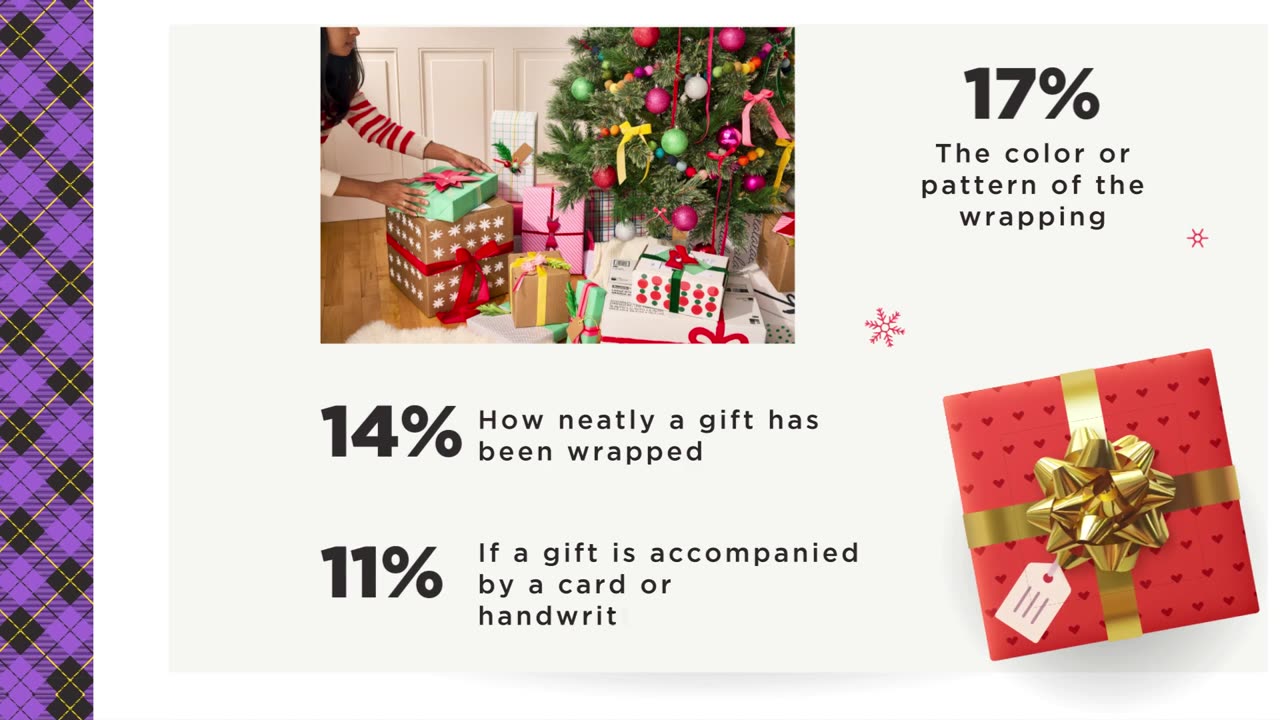Premium Only Content

Resting gift face? Most fake their excitement during the holidays
Over half of Americans have needed to use their “resting gift face” (RGF) during the holidays — masking their disappointment with a poorly presented gift.
The poll of 2,000 U.S. adults who celebrate winter holidays looked at the phenomenon of “resting gift face” RGF, which is the expression someone gives — intentionally or unintentionally — when receiving a gift that poses confusion or questions (is this a gift?) and misses the mark.
Results found that over the past three years, the average person has received two gifts they simply didn’t like, with top excitement dampeners being incomplete wrapping (14%), crumpled or old materials (13%) and mismatched holiday themes (12%).
But in most cases, people are likely to keep their responses cordial and polite. Respondents said they’d be most likely to respond to the misguided gift-giver with a, “thank you for thinking of me” (27%), “I love it” (23%) or “I really appreciate this” (21%).
This reflects a strong inclination to maintain positive interactions, emphasizing the importance of gratitude in gift-giving experiences, even when respondents aren’t keen on the gift in front of them.
Conducted by Talker Research on behalf of Scotch Brand, the survey found that avoiding eye contact is the clearest sign of gift dissatisfaction (24%).
This is followed by putting on a fake smile (20%), changing the tone of their voice (16%) or talking too much about how great the gift looks (16%).
Fifty-six percent of respondents skillfully conceal their disappointment with a “resting gift face,” and 57% believe they’ve mastered this art.
Likewise, 53% can tell “right away” when others dislike a gift. This acute awareness may resonate with anyone who’s been in the tricky position of trying to gauge the true feelings of a gift recipient.
“Resting gift face” was found to come out the most often when receiving gifts from family members (34%), significant others (29%) and friends (28%).
More than half of respondents judge presentation closely, with 54% agreeing that it matters how a present looks when they receive it.
Perhaps unsurprisingly, those who reported being skilled at wrapping are more likely to be disappointed by poor wrapping quality.
For instance, those who consider themselves expert or proficient wrappers feel less excited if the wrapping is incomplete, crumpled or outdated.
According to respondents, thoughtfulness drives joy. When receiving a gift, the top things that make it feel special are when there’s thought behind the gift (42%), it recalls a memory of the gift-giver (16%) and if it has sentimental value (15%).
With only 5% attributing the significance of a gift to its monetary value, emotional connections and sentimental value dominate recipients' joy.
Generally, 40% said they feel pressured to open gifts in front of the person they received it from.
“With the anticipation of the holiday season, we know this can bring out our need to find the perfect present and meticulously wrap them perfectly with every bow and fold,” said gift-wrapping expert, Amber Kemp-Gerstel, who’s a spokesperson for Scotch Brand.
“However, behind that intense concentration is the pure joy of giving — because nothing feels better than knowing the love you put into a gift will be felt long after the paper is torn away. With every wrap, we’re really wrapping up moments of joy.”
The survey also found when receiving gifts, the first thing people notice is the size of the gift (18%).
Beyond size, the color or pattern of wrapping paper stands out to 17%, while others take notice of how neatly it’s been wrapped (14%) and if it’s been accompanied by a card or handwritten note (11%).
Four in five (81%) believe presentation matters when giving gifts to others during the holiday, and 68% said they get more joy out of giving gifts than receiving them.
While 74% of “expert wrappers” prefer giving, only 55% of “beginner wrappers” felt the same, pointing to the added personal satisfaction that skilled wrappers associate with their gift-giving efforts.
A third claimed they were experts at gift wrapping, no matter the size or shape of the gift. Forty percent felt they were at least proficient, but admitted they struggle with uniquely shaped items. Overall, this shows that the majority of respondents possess a good level of wrapping skills.
Universally, nearly half agree the easiest and quickest way to prepare gifts is to put it in a gift bag. When it comes to gift boxes, 26% prefer them for giving, but only 19% find them easiest to open.
A quarter of respondents believe wrapping paper is noted as the easiest for opening (25%), but even fewer find it quick to open (21%).
“Wrapping a gift is more than just covering what’s inside. It’s a ritual, a moment to slow down and let intention shine through,” said Kemp-Gerstel. “Each fold and ribbon is a layer of excitement, building anticipation and joy. Because when you wrap with care, you’re not just giving a gift — you’re giving an experience.”
TOP 10 GO-TO RESPONSES FOR DISLIKED GIFTS
1. “Thank you for thinking of me” — 27%
2. “I love it” — 23%
3. “I really appreciate this” — 21%
4. “You shouldn’t have!” — 14%
5. “What a thoughtful present” — 13%
6. “What a great present” — 12%
7. “You’re too kind” — 11%
8. “It’s the thought that counts” — 10%
9. “It’s so unique!” — 9%
10. “Where did you get this?” — 8%
Survey methodology:
Talker Research surveyed 2,000 Americans who celebrate winter holidays; the survey was commissioned by Scotch™ Brand and administered and conducted online by Talker Research between Oct. 17 and Oct. 22, 2024.
We are sourcing from a non-probability frame and the two main sources we use are:
● Traditional online access panels — where respondents opt-in to take part in online market research for an incentive
● Programmatic — where respondents are online and are given the option to take part in a survey to receive a virtual incentive usually related to the online activity they are engaging in
Those who did not fit the specified sample were terminated from the survey. As the survey is fielded, dynamic online sampling is used, adjusting targeting to achieve the quotas specified as part of the sampling plan.
Regardless of which sources a respondent came from, they were directed to an Online Survey, where the survey was conducted in English; a link to the questionnaire can be shared upon request. Respondents were awarded points for completing the survey. These points have a small cash-equivalent monetary value.
Cells are only reported on for analysis if they have a minimum of 80 respondents, and statistical significance is calculated at the 95% level. Data is not weighted, but quotas and other parameters are put in place to reach the desired sample.
Interviews are excluded from the final analysis if they failed quality-checking measures. This includes:
● Speeders: Respondents who complete the survey in a time that is quicker than one-third of the median length of interview are disqualified as speeders
● Open ends: All verbatim responses (full open-ended questions as well as other please specify options) are checked for inappropriate or irrelevant text
● Bots: Captcha is enabled on surveys, which allows the research team to identify and disqualify bots
● Duplicates: Survey software has “deduping” based on digital fingerprinting, which ensures nobody is allowed to take the survey more than once
It is worth noting that this survey was only available to individuals with internet access, and the results may not be generalizable to those without internet access.
-
 0:59
0:59
SWNS
3 days agoParents reveal why they want their kids to play with toys
261 -
 30:53
30:53
Uncommon Sense In Current Times
2 days ago $9.36 earned"Pardon or Peril? How Biden’s Clemency Actions Could Backfire"
61.6K4 -
 40:01
40:01
CarlCrusher
22 hours agoSkinwalker Encounters in the Haunted Canyons of Magic Mesa - ep 4
57.6K3 -
 59:44
59:44
PMG
1 day ago $7.55 earned"BETRAYAL - Johnson's New Spending Bill EXPANDS COVID Plandemic Powers"
62.5K25 -
 6:48:50
6:48:50
Akademiks
20 hours agoKendrick Lamar and SZA disses Drake and BIG AK? HOLD UP! Diddy, Durk, JayZ update. Travis Hunter RUN
184K33 -
 11:45:14
11:45:14
Right Side Broadcasting Network
9 days agoLIVE REPLAY: TPUSA's America Fest Conference: Day Three - 12/21/24
367K28 -
 12:19
12:19
Tundra Tactical
20 hours ago $13.36 earnedDaniel Penny Beats Charges in NYC Subway Killing
78.8K16 -
 29:53
29:53
MYLUNCHBREAK CHANNEL PAGE
1 day agoUnder The Necropolis - Pt 1
166K72 -
 2:00:10
2:00:10
Bare Knuckle Fighting Championship
3 days agoCountdown to BKFC on DAZN HOLLYWOOD & FREE LIVE FIGHTS!
64.6K3 -
 2:53:01
2:53:01
Jewels Jones Live ®
1 day agoA MAGA-NIFICENT YEAR | A Political Rendezvous - Ep. 103
157K40